![]() Travel and Safari / Safari - Hitoric Cities Route
Travel and Safari / Safari - Hitoric Cities Route
[others services]
Our Safari:
![]() Historic Route
Historic Route ![]() Omo River Route
Omo River Route ![]() Kefa Gofa Sidamo & Salt Route (Dancalia/Djibouti)
Kefa Gofa Sidamo & Salt Route (Dancalia/Djibouti)
Our Expeditions
![]() Hunt Safari RVS
Hunt Safari RVS ![]() Birds Watch
Birds Watch
Our Excursions
![]() Around Addis Abeba
Around Addis Abeba
Diary and Journal:
![]() "South Ethiopia" Ethnic People of Omo River.
"South Ethiopia" Ethnic People of Omo River.
ITINERARY OF HISTORIC CITIES ROUTE
Routes and journey length:
A 9-DAY TOUR TO DISCOVER THE UNKNOWN, MYSTERIOUS AND ANCIENT HISTORY OF ETHIOPIA .
For further
information about the price of this trip, look the prices page and Click here
DEPARTURE
1° DAY Addis Abeba

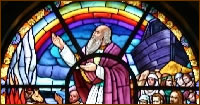
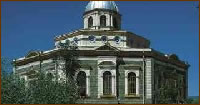
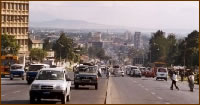 >
>
Earlymorning arrival at the Addis Abeba Airport, welcome by the Rocky Valley Safari Staff, transfer to the hotel and lunch at the hotel. In the afternoon, visit the city, the Railway station, Churchill Road, the Piazza shopping area, St. George’s Cathedral, the Trinity Cathedral (also called Selassiè Church) where lots of funerary urns and representations of the life of Jesus are preserved.
At the end of the day, visit the National Museum, where a copy of the hominid who lived three and a half million years ago is exhibited. This museum permanently displays the ceremonial clothes worn by the queens and kings that reigned in this country during several centuries. Addis Ababa became the capital of the Empire in 1889; it is located on a 2.500 m. height surrounded by a vast forest of huge eucalyptus. The climate is favourable all through the year.
Welcome dinner in a traditional restaurant with local music and dances
2° DAY Lalibela
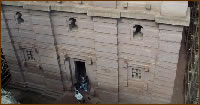

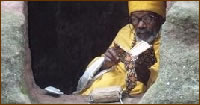 Breakfast at the hotel and transfer to the airport. Departure to Lalibela with the Rocky Valley Safari tour guides. The biggest monoliths in the African continent are visible at an altitude of 2.500 m. King Lalibela, ( 1181 – 1221 ), whose existence is mysterious, ordered the construction of a holy city, for which he invested all his fortune, his own life and his children’s. He ate herbs, slept in caves, until his majestic dream was concretized, one of the eighth wonders of the world. It was only in 1500 that this place was reached by Francisco Alvares, a Portuguese Franciscan missionary.
Breakfast at the hotel and transfer to the airport. Departure to Lalibela with the Rocky Valley Safari tour guides. The biggest monoliths in the African continent are visible at an altitude of 2.500 m. King Lalibela, ( 1181 – 1221 ), whose existence is mysterious, ordered the construction of a holy city, for which he invested all his fortune, his own life and his children’s. He ate herbs, slept in caves, until his majestic dream was concretized, one of the eighth wonders of the world. It was only in 1500 that this place was reached by Francisco Alvares, a Portuguese Franciscan missionary.
Lunch.
In the afternoon, visit the first group of monolithic churches deeply excavated from single volcanic- pink tuff blocks. These were expressly styled on the outside to arrange numerous prayer- halls. The roof of the 11 churches is at ground level. These are majestic architectures, whose building technique is still unknown. Prince Lalibela had these churches built in 1200, by drawing inspiration from Copt Egyptian churches. As the legend, goes the Prince got the help of angels for their construction. They are still used for cult, especially on Copt feasts. Many churches are masterfully frescoed and connected via underground.
Dinner and night at the hotel
3° DAY Lalibela
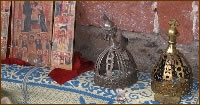
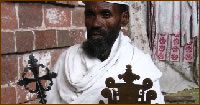
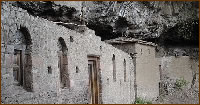 Breakfast at the hotel. Visit the Na’ akuto La’ ab Church , 7 km from Lalibela. It is a steep church built in a cave by the last descendant of King Lalibela Dinasty. Inside hang stalactites from which water drips into small stone bowls. The room temperature is obviously low. Priests jealously preserve some valuable findings, including manuscripts dating back to more than 600 yrs. ago, as well as crosses and crowns of the Zagwe Sovereigns. Lunch in Lalibela. In the afternoon, visit the second church-group, including St George’s, famous for its unique architecture. Its cross-like plan (overall, Copt crosses are 42 and all different to each other) is dug in a 13 m. deep cleft in the rock with walls thicker at the bottom and thinner towards the vault. Some caves host the mortal remains of those who chose to be buried over there. The church is spectacular especially if seen from above. It was built by king Lalibela upon the express wish of St. George appearing in a dream.
Breakfast at the hotel. Visit the Na’ akuto La’ ab Church , 7 km from Lalibela. It is a steep church built in a cave by the last descendant of King Lalibela Dinasty. Inside hang stalactites from which water drips into small stone bowls. The room temperature is obviously low. Priests jealously preserve some valuable findings, including manuscripts dating back to more than 600 yrs. ago, as well as crosses and crowns of the Zagwe Sovereigns. Lunch in Lalibela. In the afternoon, visit the second church-group, including St George’s, famous for its unique architecture. Its cross-like plan (overall, Copt crosses are 42 and all different to each other) is dug in a 13 m. deep cleft in the rock with walls thicker at the bottom and thinner towards the vault. Some caves host the mortal remains of those who chose to be buried over there. The church is spectacular especially if seen from above. It was built by king Lalibela upon the express wish of St. George appearing in a dream.
Dinner and night at the hotel
4° DAY Axum
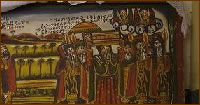
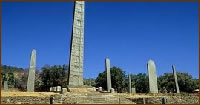 Breakfast at the hotel . Transfer to the airport and departure to Axum Expected arrival in late morning. Lunch at the hotel. In the afternoon visit the Obelisks. Axum is famous for its stelaes built in memory of the Great Emperor of Axum and the Queen of Sheba. The legend says that the Queen was born here about 1000 B.C. The power of her kingdom, ranging from the South-Arab Peninsula to eastern Africa down to Zimbabwe was reportedly due mostly to the trade of spices, perfumes, jewels, ivory and fabrics from the East to the West, which made the Kingdom of Sheba more and more powerful, and as famous as Rome, Byzantium and Persia.
Breakfast at the hotel . Transfer to the airport and departure to Axum Expected arrival in late morning. Lunch at the hotel. In the afternoon visit the Obelisks. Axum is famous for its stelaes built in memory of the Great Emperor of Axum and the Queen of Sheba. The legend says that the Queen was born here about 1000 B.C. The power of her kingdom, ranging from the South-Arab Peninsula to eastern Africa down to Zimbabwe was reportedly due mostly to the trade of spices, perfumes, jewels, ivory and fabrics from the East to the West, which made the Kingdom of Sheba more and more powerful, and as famous as Rome, Byzantium and Persia.
Dinner and night at the hotel
5° DAY Axum
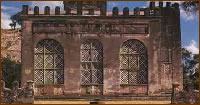 Breakfast at the hotel. The program of the day includes the visit to numerous monuments, like the bath and the palace of the Queen; the ancient cathedral of St. Mary of Sion, dating back to 1655 and founded by King Fasiladas. Near the church there is the site where an old guardian is believed to protect the Ark of the Covenant. Lunch during the visit. The day finishes with a visit to the metropolis and to the National Museum.
Breakfast at the hotel. The program of the day includes the visit to numerous monuments, like the bath and the palace of the Queen; the ancient cathedral of St. Mary of Sion, dating back to 1655 and founded by King Fasiladas. Near the church there is the site where an old guardian is believed to protect the Ark of the Covenant. Lunch during the visit. The day finishes with a visit to the metropolis and to the National Museum.
Dinner and night at the hotel.
6° DAY Axum Gondar
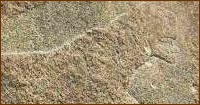
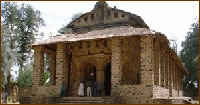 Breakfast at the hotel.
Breakfast at the hotel.
Early-morning departure to Gondar by car . Stop at Gobedra for a visit to the lionesse carved of stone. The trip continues to Debark through the Simien Park, one of the most spectacular landscapes in Africa. The Park hosts a great variety of endemic animals and birds. It occupies a large surface at altitudes between 1900 e 4400 m. After a series of gullies, slopes and steep walls, arrive at Gondar. Short of the city centre visit to the Woreka village, where the Falasha community,Ethiopian Jews, lives.
Dinner and night at the hotel
7° DAY Gondar
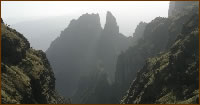
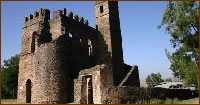 Breakfast at the hotel.
Breakfast at the hotel.
Gondar is the ancient capital of Ethiopia, established in the XVII century by Fasiladas the Great, almost certainly the most famous king of the Salomon line. His descendants embellished it with numerous monuments. At the feet of the mountains, among the ruins of imperial castles, are churches, abbeys, and baths whose architectural style is unique in Ethiopia. Visit to the castles and palaces built by the emperors during the XVII and XVIII centuries, witnessing all the magnificence of the Empire. The visit to the castles is an impressive experience of the mysterious, splendid past of the empire. Visit to the “ Fasiladas Bath”, a fortress encompassed by a tub where on Jan 6. (Little Christmas) the Ethiopian Orthodox Church celebrates Christmass. The program ends with the visit to the Debre Birhan Selassiè Church, otherwise known as “The light of the Trinity”. In this church there are beautiful wall paintings representing biblical and medieval scenes. Lunch during the visit.
Dinner and night at the hotel.
8° DAY Gondar - Bahar Dar
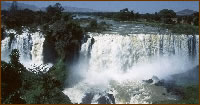
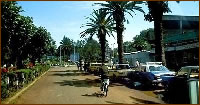
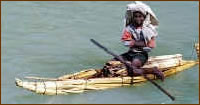 Breakfast at the hotel.
Breakfast at the hotel.
Early-morning departure to Bahar Dar by car . Nearly 31 kms to Bahar Dar, visit the Blue Nile Waterfalls. This spectacular site is known world-wide mainly because of the morning-rainbow phenomenon due to the light refraction. Lunch; In the afternoon,sail by boat to one of the Islands in Lake Tana and visit the church ,Ura Kidane Mehret ,which is open to men and women. Inside this church are valuable wall paintings. Nearby, the House of Treasure, where invaluable treasures are kept, like manuscripts, icons, holy crosses, clothes and crowns belonging to kings and feudal lords of the past. . Return to Bahar Dar in the evening.
Dinner and night at the hotel.
9° DAY Bahar Dar – Addis Abeba
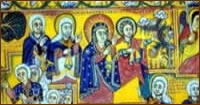
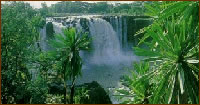 Breakfast at the hotel.
Breakfast at the hotel.
Bahar Dar overlooks the Tana Lake; it is in the South of the famous heart-shaped lake, the source of the Blue Nile, the most important Ethiopian water-basin. Together with the White Nile it flows into the Nile, the sacred, historical river. The Blue Nile begins its long flow to the sea with a 50 m. fall, just a few kilometres from the Tana Lake, which is 14 m deep, 75 km long and 60 km wide. More than 30 lush islands are scattered on the lake. Many of these host mud and wood monasteries and churches dating back to the XIV century. Visit the city at the end of the day. Transfer to the airport and departure to Addis Ababa.
Accommodation at the Ghion Hotel. Farewell dinner in another typical restaurant in town.
NOTES:
We recommend air transportation to reach historical cities (Lalibela, Axum, Gondar and Bahar Dar) in order to accelerate transfers and to include the visit to the Omo River Valley. All this in just 9 days. For travellers with more time available and just with two extra days, it is possible to complete the Historical Route Tour by car. This option includes the visit to the Semien Park. Flight reservation international and local can must be aranged by passengers. We suggest Ethiopian Airlines, the national carrier, RVS will assist the group leader in this regard.